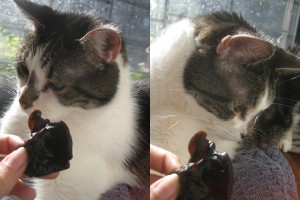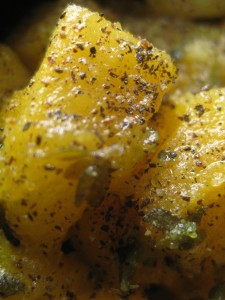We have made it through an entire tomato season having only woken up a handful of times to a mauled tomato on the living room floor. This is progress. I think the progress is mostly due to the habit we’ve developed of hiding our tomatoes like Easter eggs rather than any real rehabilitation on the part of Oscar (a.k.a. The Tomato Slayer). But progress nonetheless.
The other day, while Oscar was busy seducing the top of a soy sauce bottle, I hatched a new theory about his unnatural tomato love. Maybe he is so nuts about them because of umami, that mysterious fifth taste that English has hard time capturing in words. Most people say it corresponds to savory, the taste of meat and MSG and ketchup (and…tomatoes?!) A quick Google search had me feeling smug; there were multiple reports of carnivorous housecats attacking non-meat items that are rich in that umami taste, particularly mushrooms. Oscar has never shown a particular taste for mushrooms, even the ones that I grew on my windowsill, but he does have a discriminating palate, so I decided to rehydrate one of our fancy Chinese black mushrooms and run a little experiment. Perhaps I had finally plumbed the secrets of the Tomato Slayer’s inner workings.
But the response was… Continue reading




